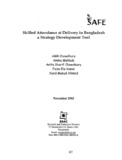| dc.identifier.citation | Chowdhury, A., Mahbub, A., Chowdhury, A. S., Kamal, F. E., & Ahmed, S. M. (2002, November). Skilled attendance at delivery in Bangladesh a strategy development tool. Research Reports (2002): Health Studies, Vol - XXXII, 67–215. | en_US |
| dc.description.abstract | SAFE study aimed to provide new knowledge on the identification, implementation and
evaluation of effective, affordable and equitable strategies to increase Skilled Attendance
at delivery in developing countries. It was a multi country research and five countries
..
including Bangladesh were involved in this study. The main purpose of SAFE study was
to develop a Strategy Development Tool (SDT), which would enable the policy makers
and programme planners to systematically gather and interpret information on skilled
attendance at delivery. The SDT contained five components, which revealed the
collection, analysis and synthesis of existing and new data on skilled attendance. The
five modules were: problem identification, situation analysis, needs assessment, quality
of clinical care and synthesis. The cost of the application of the SDT was also examined
during SAFE study as part of the field test to consider the affordability.
In Bangladesh under SAFE study using the SDT, certain strategy options to promote
skilled attendance at delivery were developed. The key findings in SAFE study and the
strategy options are given in the following.
A review of existing literature showed that in Bangladesh only 7% of deliveries were
assisted by qualified medical practitioners, while 22% by relatives and almost half by
traditional birth attendants (TBAs). At community level where home delivery was
almost universal certain factors were related to skilled attendance at delivery: mother's
age and education, religion, residence poverty status and child's birth order. It was found
that proportion of deliveries done at health facilities were highly inequitable. Whereas
the proportion of well-to-do women delivering in a facility was 17.3 percent, it was less
than one percent for the poorest women. DHS 1 data (1999-'00) revealed that women
who had used health facilities for other health services like immunisation, contraception,
and antenatal care (ANC) in the past used health facilities for deliveries more frequently
compared to others. DHS data also showed that the proportion delivered at a Govt.
Hospital increased by four times who had 4+ ANC visits, but the need assessment study
reve~led that ANC during pregnancy was not that considered important by the women for
the purpose of delivery;
The need assessment study also identitied a number of barriers at different levels which
hindered women's access to fomlal deiivery care. At individual level women were not ,
willing to deliver in the hospital due to shame, fear of caesarean and death. At family
level it was noted that the major decision makers i.e. mothers-in-law, husbands were the
least knowledgeable about different level of obstetric services, which eventually
increased the expenditure of delivery care. In the need assessment study, the villagers
pointed out that in emergencies the neighbours extended their cooperation. However, as
most of them were poor, often it was difficult for them to provide financial support or
loans. Thus, economic constraints were noted as one of the major hindrances in
accessing fonnal delivery care services. At community level it was found that
neighbours discouraged to go to the health facilities for delivery care and over
dependence on TBAs was also noted. The key informants pointed out that although
many NGOs in Bangladesh had motivational activities at community level, but those
were not adequate for promoting skilled attendance. The study revealed that at facility
level unfriendly behaviour of the healthcare providers, lack of female doctors and
problems in the system of referral prevented people's access to formal delivery care
The study indicated that doctors at Upazila (sub district) level mostly did not have
specialised obs & gynae training, which limited service provision. The qualified health
care providers were found to be concentrated in the urban areas and few female doctors
could be found in rural areas. Most of the key informants opined that lack of professional
commitment was a major problem in promoting skilled attendance in Bangladesh. The
doctors posted at the Upazilas were mostly found not to reside in the campus and were
more interested in private practice. | en_US |

